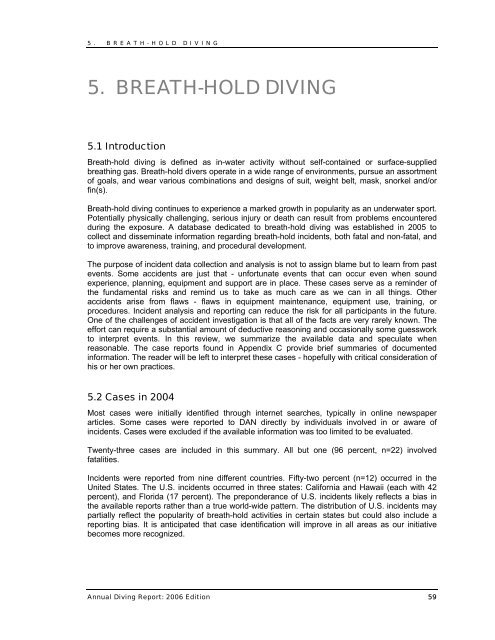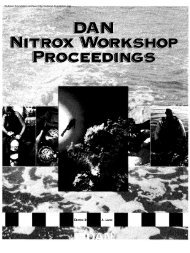Annual Diving Report - Divers Alert Network
Annual Diving Report - Divers Alert Network
Annual Diving Report - Divers Alert Network
You also want an ePaper? Increase the reach of your titles
YUMPU automatically turns print PDFs into web optimized ePapers that Google loves.
5. BREATH-HOLD DIVING<br />
5. BREATH-HOLD DIVING<br />
5.1 Introduction<br />
Breath-hold diving is defined as in-water activity without self-contained or surface-supplied<br />
breathing gas. Breath-hold divers operate in a wide range of environments, pursue an assortment<br />
of goals, and wear various combinations and designs of suit, weight belt, mask, snorkel and/or<br />
fin(s).<br />
Breath-hold diving continues to experience a marked growth in popularity as an underwater sport.<br />
Potentially physically challenging, serious injury or death can result from problems encountered<br />
during the exposure. A database dedicated to breath-hold diving was established in 2005 to<br />
collect and disseminate information regarding breath-hold incidents, both fatal and non-fatal, and<br />
to improve awareness, training, and procedural development.<br />
The purpose of incident data collection and analysis is not to assign blame but to learn from past<br />
events. Some accidents are just that - unfortunate events that can occur even when sound<br />
experience, planning, equipment and support are in place. These cases serve as a reminder of<br />
the fundamental risks and remind us to take as much care as we can in all things. Other<br />
accidents arise from flaws - flaws in equipment maintenance, equipment use, training, or<br />
procedures. Incident analysis and reporting can reduce the risk for all participants in the future.<br />
One of the challenges of accident investigation is that all of the facts are very rarely known. The<br />
effort can require a substantial amount of deductive reasoning and occasionally some guesswork<br />
to interpret events. In this review, we summarize the available data and speculate when<br />
reasonable. The case reports found in Appendix C provide brief summaries of documented<br />
information. The reader will be left to interpret these cases - hopefully with critical consideration of<br />
his or her own practices.<br />
5.2 Cases in 2004<br />
Most cases were initially identified through internet searches, typically in online newspaper<br />
articles. Some cases were reported to DAN directly by individuals involved in or aware of<br />
incidents. Cases were excluded if the available information was too limited to be evaluated.<br />
Twenty-three cases are included in this summary. All but one (96 percent, n=22) involved<br />
fatalities.<br />
Incidents were reported from nine different countries. Fifty-two percent (n=12) occurred in the<br />
United States. The U.S. incidents occurred in three states: California and Hawaii (each with 42<br />
percent), and Florida (17 percent). The preponderance of U.S. incidents likely reflects a bias in<br />
the available reports rather than a true world-wide pattern. The distribution of U.S. incidents may<br />
partially reflect the popularity of breath-hold activities in certain states but could also include a<br />
reporting bias. It is anticipated that case identification will improve in all areas as our initiative<br />
becomes more recognized.<br />
<strong>Annual</strong> <strong>Diving</strong> <strong>Report</strong>: 2006 Edition 59

















